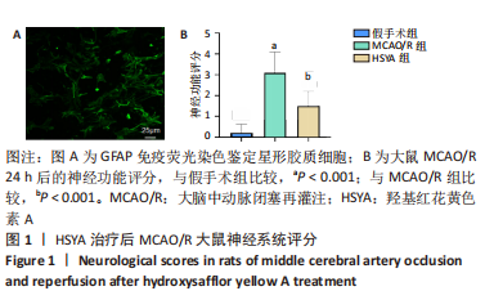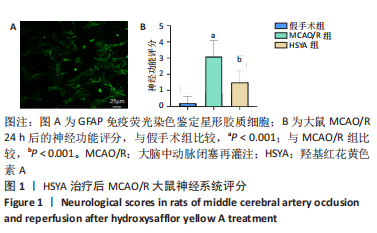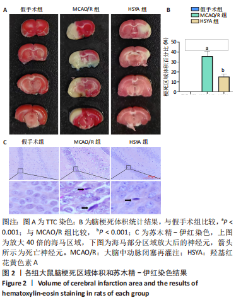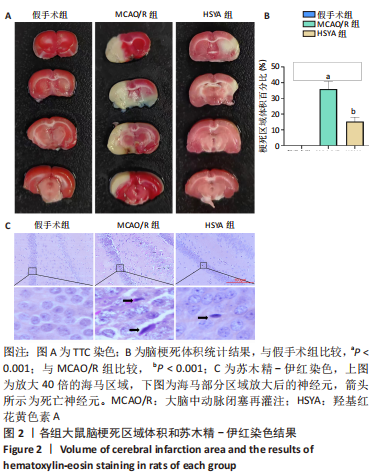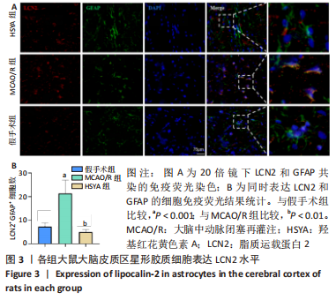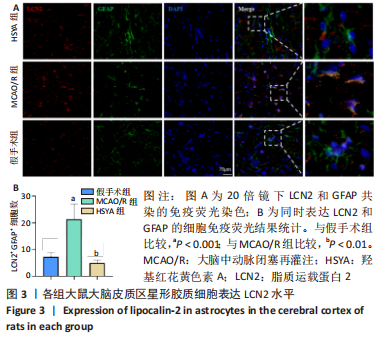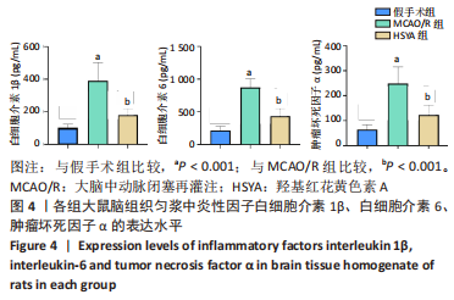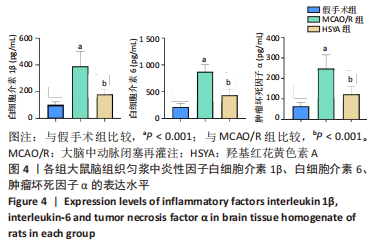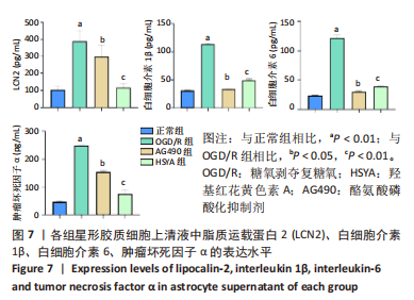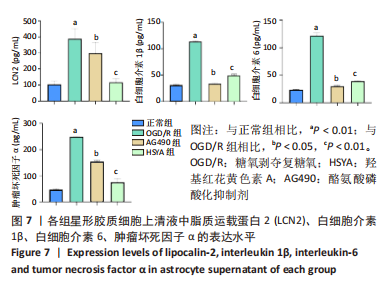Chinese Journal of Tissue Engineering Research ›› 2024, Vol. 28 ›› Issue (7): 1063-1069.doi: 10.12307/2024.119
Previous Articles Next Articles
Hydroxysafflor yellow A intervenes astrocyte lipocalin 2 expression after cerebral ischemia/reperfusion injury
Liu Kexin1, Song Lijuan1, 2 , 3, Wu Yige1, Han Guangyuan1, Miao Zhuyue1, Wei Ruheng1, Xiao Baoguo4, Ma Cungen1, Huang Jianjun1, 3
- 1Key Research Laboratory of Benefiting Qi for Acting Blood Circulation Method to Treat Multiple Sclerosis of State Administration of Chinese Medicine/Research Center of Neurobiology, Shanxi University of Chinese Medicine, Jinzhong 030619, Shanxi Province, China; 2Key Laboratory of Cell Physiology Jointly Established by Province and Ministry of Education, Shanxi Medical University, Taiyuan 030001, Shanxi Province, China; 3Department of Neurosurgery, Sinopharm Tongmei General Hospital, Datong 037003, Shanxi Province, China; 4Institute of Neurology, Institutes of Brain Science and State Key Laboratory of Medical Neurobiology, Fudan University, Shanghai 200025, China
-
Received:2022-12-30Accepted:2023-03-14Online:2024-03-08Published:2023-07-17 -
Contact:Huang Jianjun, Master, Chief physician, Key Research Laboratory of Benefiting Qi for Acting Blood Circulation Method to Treat Multiple Sclerosis of State Administration of Chinese Medicine/Research Center of Neurobiology, Shanxi University of Chinese Medicine, Jinzhong 030619, Shanxi Province, China; Department of Neurosurgery, Sinopharm Tongmei General Hospital, Datong 037003, Shanxi Province, China Song Lijuan, MD, Associate professor, Key Research Laboratory of Benefiting Qi for Acting Blood Circulation Method to Treat Multiple Sclerosis of State Administration of Chinese Medicine/Research Center of Neurobiology, Shanxi University of Chinese Medicine, Jinzhong 030619, Shanxi Province, China; Key Laboratory of Cell Physiology Jointly Established by Province and Ministry of Education, Shanxi Medical University, Taiyuan 030001, Shanxi Province, China; Department of Neurosurgery, Sinopharm Tongmei General Hospital, Datong 037003, Shanxi Province, China -
About author:Liu Kexin, Master, Key Research Laboratory of Benefiting Qi for Acting Blood Circulation Method to Treat Multiple Sclerosis of State Administration of Chinese Medicine/Research Center of Neurobiology, Shanxi University of Chinese Medicine, Jinzhong 030619, Shanxi Province, China Song Lijuan, MD, Associate professor, Key Research Laboratory of Benefiting Qi for Acting Blood Circulation Method to Treat Multiple Sclerosis of State Administration of Chinese Medicine/Research Center of Neurobiology, Shanxi University of Chinese Medicine, Jinzhong 030619, Shanxi Province, China; Key Laboratory of Cell Physiology Jointly Established by Province and Ministry of Education, Shanxi Medical University, Taiyuan 030001, Shanxi Province, China; Department of Neurosurgery, Sinopharm Tongmei General Hospital, Datong 037003, Shanxi Province, China -
Supported by:National Natural Science Foundation of China, No. 82004028 (to SLJ); Horizontal Project of Sinopharm Tongmei General Hospital, No. 202209SY01 (to SLJ); China Postdoctoral Science Foundation, No. 2020M680912 (to SLJ); Cardiovascular Special Fund Project of National Regional Traditional Chinese Medicine Medical Center of Affiliated Hospital of Shanxi University of Chinese Medicine in 2021, No. XGZX202115 (to SLJ); Discipline Construction Fund of Shanxi University of Chinese Medicine (to MCG); Leading Team of Medical Science and Technology of Shanxi Province, No. 2020TD05 (to MCG); Young Scientists Cultivation Project of Shanxi University of Chinese Medicine in 2021, No. 2021PY-QN-09 (to SLJ); The 2022 Scientific and Technological Innovation Team of Shanxi University of Chinese Medicine, No. 2022TD2010 (to SLJ); 2022 Shanxi Provincial Science and Technology Innovation Talent Team, No. 202204051001028 (to SLJ)
CLC Number:
Cite this article
Liu Kexin, Song Lijuan, Wu Yige, Han Guangyuan, Miao Zhuyue, Wei Ruheng, Xiao Baoguo, Ma Cungen, Huang Jianjun. Hydroxysafflor yellow A intervenes astrocyte lipocalin 2 expression after cerebral ischemia/reperfusion injury[J]. Chinese Journal of Tissue Engineering Research, 2024, 28(7): 1063-1069.
share this article
Add to citation manager EndNote|Reference Manager|ProCite|BibTeX|RefWorks
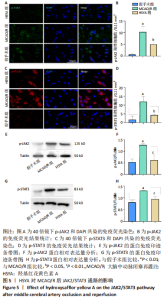
2.5 HSYA抑制MCAO/R后p-JAK2/p-STAT3信号通路 为了进一步确定HSYA对MCAO/R后p-JAK2和p-STAT3的影响,对大鼠脑片进行了免疫荧光染色,结果观察到在MCAO/R后大鼠大脑皮质梗死区的JAK2/STAT3信号通路磷酸化程度增强。与假手术组比较,MCAO/R组p-JAK2和p-STAT3阳性的细胞数量明显增多(P < 0.01),而HSYA组中表达p-JAK2、p-STAT3的细胞数量减少(P < 0.05)。Western blot结果表明,HSYA降低了MCAO/R后p-JAK2蛋白与p-STAT3蛋白的表达(P < 0.01)。实验证实了HSYA对MCAO/R后激活的JAK2/STAT3通路具有显著的抑制效果,见图5。"
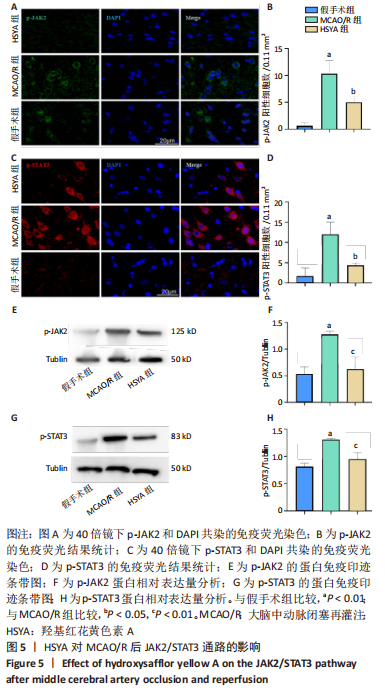
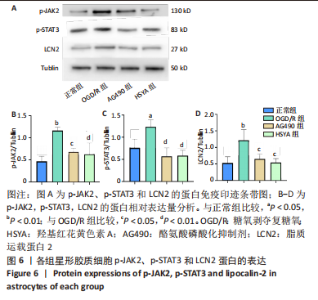
2.6 HSYA通过JAK2/STAT3通路抑制LCN2表达 为明确HSYA是否通过JAK2/STAT3通路抑制LCN2表达,在星形胶质细胞OGD/R的同时,加入JAK2和STAT3的抑制剂AG490。Western blot结果显示,与正常组相比,OGD/R组JAK2和STAT3磷酸化程度加重(P < 0.01);与OGD/R组比较,AG490干预组p-JAK2、p-STAT3、LCN2表达被抑制(P < 0.05,P < 0.01)。HSYA组p-JAK2、p-STAT3、LCN2表达同样被抑制(P < 0.05)。以上结果显示,HSYA可能通过抑制JAK2/STAT3通路发挥抑制LCN2表达的作用,见图6。"
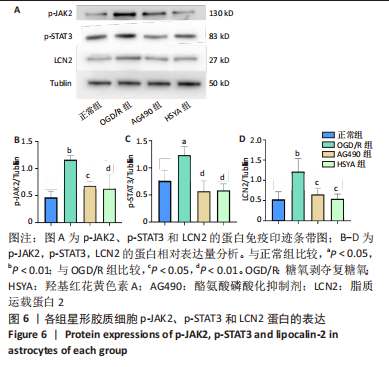
| [1] BARTHELS D, DAS H. Current advances in ischemic stroke research and therapies. Biochim Biophys Acta Mol Basis Dis. 2020;1866(4):165260. [2] ANRATHER J, IADECOLA C. Inflammation and Stroke: An Overview. Neurotherapeutics. 2016;13(4):661-670. [3] SOFRONIEW MV. Astrocyte Reactivity: Subtypes, States, and Functions in CNS Innate Immunity. Trends Immunol. 2020;41(9):758-770. [4] PEKNY M, WILHELMSSON U, TATLISUMAK T, et al. Astrocyte activation and reactive gliosis-A new target in stroke? Neurosci Lett. 2019;689:45-55. [5] SUK K. Lipocalin-2 as a therapeutic target for brain injury: An astrocentric perspective. Prog Neurobiol. 2016;144:158-172. [6] KEHRER JP. Lipocalin-2: pro- or anti-apoptotic? Cell Biol Toxicol. 2010;26(2):83-89. [7] CHAKRABORTY S, KAUR S, GUHA S, et al. The multifaceted roles of neutrophil gelatinase associated lipocalin (NGAL) in inflammation and cancer. Biochim Biophys Acta. 2012; 1826(1):129-169. [8] XU WX, ZHANG J, HUA YT, et al. An Integrative Pan-Cancer Analysis Revealing LCN2 as an Oncogenic Immune Protein in Tumor Microenvironment. Front Oncol. 2020;10:605097. [9] LIU R, WANG J, CHEN Y, et al. NOX activation in reactive astrocytes regulates astrocytic LCN2 expression and neurodegeneration. Cell Death Dis. 2022;13(4):371. [10] WAN T, ZHU W, ZHAO Y, et al. Astrocytic phagocytosis contributes to demyelination after focal cortical ischemia in mice. Nat Commun. 2022;13(1):1134. [11] LUO C, ZHOU S, YIN S, et al. Lipocalin-2 and Cerebral Stroke. Front Mol Neurosci. 2022; 15:850849. [12] WU ZL, CIALLELLA JR, FLOOD DG, et al. Comparative analysis of cortical gene expression in mouse models of Alzheimer’s disease. Neurobiol Aging. 2006;27(3):377-386. [13] MARQUES F, RODRIGUES AJ, SOUSA JC, et al. Lipocalin 2 is a choroid plexus acute-phase protein. J Cereb Blood Flow Metab. 2008;28(3):450-455. [14] ZHAO N, XU X, JIANG Y, et al. Lipocalin-2 may produce damaging effect after cerebral ischemia by inducing astrocytes classical activation. J Neuroinflammation. 2019;16(1): 168. [15] AGASHE RP, LIPPMAN SM, KURZROCK R. JAK: Not Just Another Kinase. Mol Cancer Ther. 2022;21(12):1757-1764. [16] O’CALLAGHAN JP, KELLY KA, VANGILDER RL, et al. Early activation of STAT3 regulates reactive astrogliosis induced by diverse forms of neurotoxicity. PLoS One. 2014;9(7): e102003. [17] OKADA S, NAKAMURA M, KATOH H, et al. Conditional ablation of Stat3 or Socs3 discloses a dual role for reactive astrocytes after spinal cord injury. Nat Med. 2006; 12(7):829-834. [18] WU M, WANG L, LI F, et al. Resveratrol Downregulates STAT3 Expression and Astrocyte Activation in Primary Astrocyte Cultures of Rat. Neurochem Res. 2020;45(2):455-464. [19] LI H, ZHANG Q, ZHANG G. Signal transducer and activator of transcription-3 activation is mediated by N-methyl-D-aspartate receptor and L-type voltage-gated Ca2+ channel during cerebral ischemia in rat hippocampus. Neurosci Lett. 2003;345(1):61-64. [20] HRISTOVA M, ROCHA-FERREIRA E, FONTANA X, et al. Inhibition of Signal Transducer and Activator of Transcription 3 (STAT3) reduces neonatal hypoxic-ischaemic brain damage. J Neurochem. 2016;136(5):981-994. [21] ZHANG X, SHEN D, FENG Y, et al. Pharmacological Actions, Molecular Mechanisms, Pharmacokinetic Progressions, and Clinical Applications of Hydroxysafflor Yellow A in Antidiabetic Research. J Immunol Res. 2021;2021:4560012. [22] CHEN S, SUN M, ZHAO X, et al. Neuroprotection of hydroxysafflor yellow A in experimental cerebral ischemia/reperfusion injury via metabolic inhibition of phenylalanine and mitochondrial biogenesis. Mol Med Rep. 2019;19(4):3009-3020. [23] SUN Y, XU DP, QIN Z, et al. Protective cerebrovascular effects of hydroxysafflor yellow A (HSYA) on ischemic stroke. Eur J Pharmacol. 2018;818:604-609. [24] 戴纪恒.基于SIRT1-HIF-1α-VEGFA信号转导通路探讨羟基红花黄色素A调控血管新生保护氧糖剥夺/复糖复氧损伤大鼠脑微血管内皮细胞[D].合肥:安徽中医药大学,2020. [25] 戚智锋,师文娟,闫峰,等.羟基红花黄色素A对脑缺血-再灌注大鼠星形胶质细胞活性的影响[J].中国脑血管病杂志,2013,10(9):488-491. [26] 田京伟,傅风华,蒋王林,等.羟基红花黄色素A对脑缺血所致大鼠脑线粒体损伤的保护作用[J].药学学报,2004,39(10):774-777. [27] PAN H, XU Y, CAI Q, et al. Effects of β-Asarone on Ischemic Stroke in Middle Cerebral Artery Occlusion Rats by an Nrf2-Antioxidant Response Elements (ARE) Pathway-Dependent Mechanism. Med Sci Monit. 2021;27:e931884. [28] 曹水娟.羟基红花黄色素A促大鼠局灶性脑缺血后血管新生作用的分子基础初探[D].北京:中国协和医科大学,2007. [29] 韩光远,刘可心,魏汝恒,等.羟基红花黄色素A对糖氧剥夺/复糖复氧后星形胶质细胞保护作用及其机制研究[J].中国免疫学杂志,2022,38(3):275-281. [30] DOWLATI A, NETHERY D, KERN JA. Combined inhibition of epidermal growth factor receptor and JAK/STAT pathways results in greater growth inhibition in vitro than single agent therapy. Mol Cancer Ther. 2004;3(4):459-463. [31] ASCHNER M. Immune and inflammatory responses in the CNS: modulation by astrocytes. Toxicol Lett. 1998;102-103:283-287. [32] IADECOLA C, BUCKWALTER MS, ANRATHER J. Immune responses to stroke: mechanisms, modulation, and therapeutic potential. J Clin Invest. 2020;130(6):2777-2788. [33] WEI R, SONG L, MIAO Z, et al. Hydroxysafflor Yellow A Exerts Neuroprotective Effects via HIF-1α/BNIP3 Pathway to Activate Neuronal Autophagy after OGD/R. Cells. 2022; 11(23):3726. [34] JANG E, KIM JH, LEE S, et al. Phenotypic polarization of activated astrocytes: the critical role of lipocalin-2 in the classical inflammatory activation of astrocytes. J Immunol. 2013;191(10):5204-5219. [35] ZHU H, JIAN Z, ZHONG Y, et al. Janus Kinase Inhibition Ameliorates Ischemic Stroke Injury and Neuroinflammation Through Reducing NLRP3 Inflammasome Activation via JAK2/STAT3 Pathway Inhibition. Front Immunol. 2021;12:714943. [36] YU L, LIU Z, HE W, et al. Hydroxysafflor Yellow A Confers Neuroprotection from Focal Cerebral Ischemia by Modulating the Crosstalk Between JAK2/STAT3 and SOCS3 Signaling Pathways. Cell Mol Neurobiol. 2020;40(8):1271-1281. |
| [1] | Yue Yun, Wang Peipei, Yuan Zhaohe, He Shengcun, Jia Xusheng, Liu Qian, Li Zhantao, Fu Huiling, Song Fei, Jia Menghui. Effects of croton cream on JNK/p38 MAPK signaling pathway and neuronal apoptosis in cerebral ischemia-reperfusion injury rats [J]. Chinese Journal of Tissue Engineering Research, 2024, 28(8): 1186-1192. |
| [2] | Yang Ting, Ding Zhibin, Jiang Nan, Han Hongxia, Hou Miaomiao, Ma Cungen, Song Lijuan, Li Xinyi. Astrocytes regulate glial scar formation in cerebral ischemic stroke [J]. Chinese Journal of Tissue Engineering Research, 2024, 28(1): 131-138. |
| [3] | Long Qingxi, Zhang Pingshu, Liu Qing, Ou Ya, Zhang Lili, Yuan Xiaodong. Single-cell RNA sequencing reveals the heterogeneity of astrocytes [J]. Chinese Journal of Tissue Engineering Research, 2024, 28(1): 139-146. |
| [4] | Nie Chenchen, Su Kaiqi, Gao Jing, Fan Yongfu, Ruan Xiaodi, Yuan Jie, Duan Zhaoyuan, Feng Xiaodong. The regulatory role of circular RNAs in cerebral ischemia-reperfusion injury [J]. Chinese Journal of Tissue Engineering Research, 2023, 27(8): 1286-1291. |
| [5] | Gao Yu, Han Jiahui, Ge Xin. Immunoinflammatory microenvironment after spinal cord ischemia-reperfusion injury [J]. Chinese Journal of Tissue Engineering Research, 2023, 27(8): 1300-1305. |
| [6] | Hao Liufang, Duan Hongmei, Wang Zijue, Hao Fei, Hao Peng, Zhao Wen, Gao Yudan, Yang Zhaoyang, Li Xiaoguang. Spatiotemporal dynamic changes of ependymal cells after spinal cord injury in transgenic mice [J]. Chinese Journal of Tissue Engineering Research, 2023, 27(6): 883-889. |
| [7] | Chen Guodong, Zheng Meiyan, Zhang Peng, Wang Zhenchao, Jin Lixin. Changes in sensory neurons and astrocytes and the expression of interleukin 1beta and glial fibrillary acidic protein in the rat spinal cord after selective dorsal rhizotomy [J]. Chinese Journal of Tissue Engineering Research, 2023, 27(5): 726-731. |
| [8] | Wang Shaona, Liu Feixiang, Ying Chunmiao, Gao Chen, Zhang Yunke. Action mechanism of traditional Chinese medicine combined with bone marrow mesenchymal stem cells in regulating blood-brain barrier after cerebral ischemia reperfusion injury [J]. Chinese Journal of Tissue Engineering Research, 2023, 27(33): 5377-5384. |
| [9] | Wang Mingsheng, Cui Huanxi, Cui Hongkai, Pei Guanhui, Li Daoguang, Yan Haiqing, Zhang Ping. Ngn2 effects on brain microstructure and keratinocyte activity in cerebral ischemia rats via regulating Nrf2/HO-1 [J]. Chinese Journal of Tissue Engineering Research, 2023, 27(33): 5298-5303. |
| [10] | Ma Ruixin, Liu Pan, Zhang Qiong, Zeng Gaofeng, Zong Shaohui. Molecular mechanism of total flavonoids of hawthorn leaves regulating astrocytes to repair spinal cord injury [J]. Chinese Journal of Tissue Engineering Research, 2023, 27(33): 5327-5333. |
| [11] | Hua Xiaoqiong, Li Yanjie, Qin Hewei, Jin Xiaoqin, Ren Kun, Zhang Zhixin, Zhu Bochao, Wang Yupu. Acupoint dressing therapy using Expectorant Choking Formula for swallowing disorders in rats after cerebral ischemia-reperfusion injury [J]. Chinese Journal of Tissue Engineering Research, 2023, 27(32): 5155-5161. |
| [12] | Ma Hui, Sun Zhengqi, Li Yansong. Effect of Ratnasampil on pia microcirculation and glial scar in a rat model of cerebral infarction [J]. Chinese Journal of Tissue Engineering Research, 2023, 27(28): 4462-4467. |
| [13] | Zhang Junyu, Zhang Lida, Hu Yanqi, Jin Zikai, Luo Fuci, Wu Xiaoqing, Tong Tingting, Song Xiaoge, Han Wei. Expression of microRNA-124 and cortical proteins in ischemic penumbra of rats pretreated with “Tongdu Tiaoshen” electroacupuncture [J]. Chinese Journal of Tissue Engineering Research, 2023, 27(26): 4139-4146. |
| [14] | Wang Liping, Li Jisheng, Deng Li, Wang Zhiqiang, Liu Jinming, Deng Chen, Sun Lin. Effects of high-mobility group box 1 on different subtypes of rat spinal reactive astrocytes after oxygen-glucose deprivation/restoration in vitro [J]. Chinese Journal of Tissue Engineering Research, 2023, 27(24): 3831-3837. |
| [15] | Cai Chuang, Huang Yonghui, Cao Xingbing, Sun Haitao, Guan Shihao, Huang Wenkang, Han Bo. Astrocyte-derived extracellular vesicles promote the differentiation of rat neural stem cells into neurons [J]. Chinese Journal of Tissue Engineering Research, 2023, 27(24): 3845-3851. |
| Viewed | ||||||
|
Full text |
|
|||||
|
Abstract |
|
|||||
